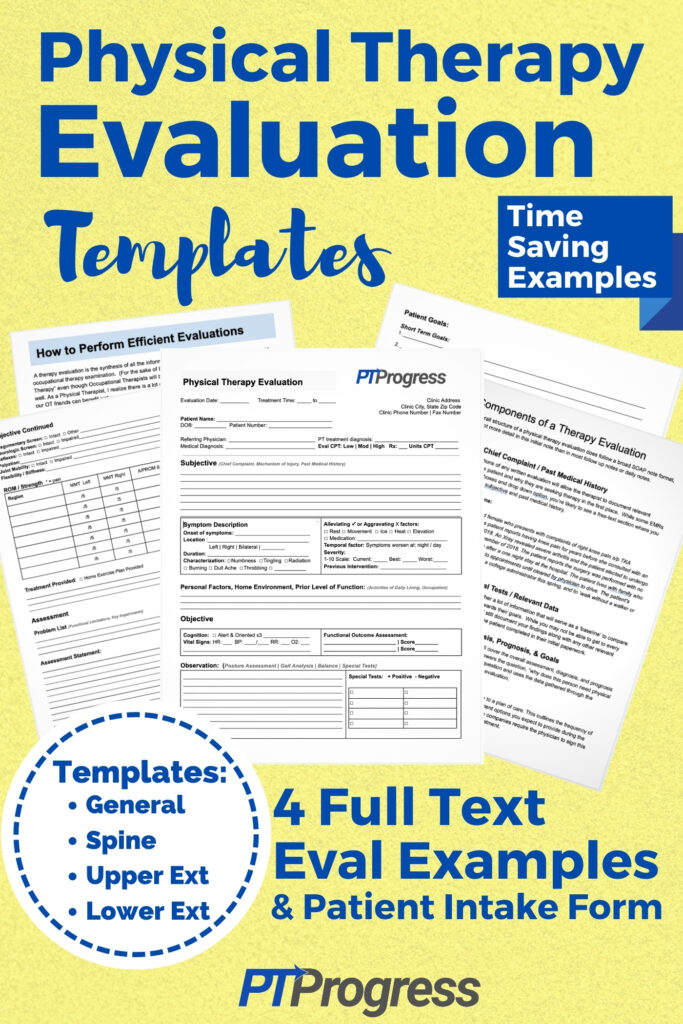


A physical therapy evaluation synthesizes all the information you gather during an examination. Oftentimes, the terms physical therapy “evaluation” and “examination” are used interchangeably when referring to the patient’s first encounter with a Physical Therapist.
In this article, we’ll discuss the components necessary to write a physical therapy evaluation as well as the basic structure of an examination. You can also download a physical therapy evaluation example to use as a template.
If you’re a student or newly-graduated PT, you’re probably familiar with a physical therapy evaluation. But before diving into the how behind writing a good evaluation, let’s review the why and the what.
A Physical Therapy evaluation is your first encounter with a patient. Importantly, it sets the expectations for the rest of the “plan of care,” or the time you anticipate seeing the patient. Your evaluation documentation will become a part of the patient’s medical records, along with the notes from every subsequent visit.
The records you keep are important because other therapists, physicians, and even the patient’s health insurance company may reference them in the future. The patient may also request their therapy notes, so it’s important to write accurately and thoroughly.
An initial patient evaluation occurs in two parts: the clinical examination and the written therapy evaluation.
Clinical Examination: Most clinics set aside 45 to 60 minutes for the initial evaluation. Expect to cover the following information:

Written Evaluation: You’ll finish the clinical evaluation by documenting your findings as a professional assessment of the patient’s need for therapy. The written evaluation may take anywhere from 15 to 45 minutes to complete after you’re done with your visit, depending on the amount of information to report and the efficiency of your documentation system.
The rest of this article will delve further into the components of an initial examination and its counterpart, your written evaluation. For optimal efficiency and accuracy, use my physical therapy evaluation templates and therapy evaluation examples.
You can check those out here.
A thorough therapy evaluation begins with a report of your examination. Let’s explore more in-depth how each component of your examination can strengthen the notes you write afterwards.
Before you even see the patient, you’ll look over the patient intake form. A good patient intake form is like a concise roadmap that will help you identify some of the major issues and questions to ask during the actual examination.
With every patient, your first impression impacts the rest of the session. It’s important to put the patient at ease with careful wording, so consider using the exact formula I share in my Evaluation Templates. While you shouldn’t write out every question you plan to ask the patient, you should be able to talk conversationally as you discern the best treatment plan.
One of the first elements covered in a physical therapy evaluation is the patient’s medical history. As the physical therapist, you should inquire about their medical history carefully and intentionally. Without specific questions, the conversation could spiral down a path of irrelevant information. Be direct; ask the patient about pertinent medical history and the events that led them to seek physical therapy.
As you start gathering information from the patient during your exam, you’ll hone in on specific questions to identify how various body systems are involved. You’ll rely on critical thinking skills to sift through various systems, from neuromuscular to cardiovascular and integumentary.
Your understanding of how these body systems respond based on the patient’s symptoms and presentation will inform your diagnosis and treatment plan.
During the examination, you’ll use a variety of special tests and measurement tools to gather relevant information about the patient. From ROM (range of motion) to MMT (manual muscle testing) and neuro screening tests, your exam can be tailored to the individual patient.
That being said, you don’t need to perform every special test available to conduct a thorough exam. As you grow in your PT career, you’ll become wiser and more time-efficient in assessing each patient.
Interested in learning more about the special tests you may conduct in an examination? Visit our Special Tests page.
After gathering and analyzing all this information, by the end of the exam you will understand key factors contributing to the patient’s pain, discomfort, or overall functional limitations. Try to briefly summarize to the patient your initial prognosis and plan for their care. As you present your findings, be aware that people respond to this type of news differently, no matter the diagnosis. Whether they have a minor injury like an ankle sprain or a major surgery like a total joint replacement, you should weigh your words sensitively.
The initial physical therapy visit may include treatment intervention. Sometimes, a good way to wrap up an examination is by identifying specific movements and helpful exercises. At the end of the session, you’ll likely provide a list of home exercises the patient can do before they see you again.
You won’t part ways with your patient before setting an expectation of visit frequency and recommended treatment. What you prescribe may or may not correspond to the general recommendations provided on the physician’s script for PT.
After the initial examination is finished, you’ll need to write up the evaluation.
In almost every clinic I’ve worked in, I used the electronic medical record (EMR) to type and document findings during the examination itself. This gave me a head start in completing the evaluation and saved valuable time afterwards.
Having a framework for your exam will help you become more efficient in documenting your findings while you’re with the patient.
Although it’s helpful to “document as you go,” don’t expect to finish the entire written evaluation within the examination time. You’ll likely spend another 15-45 minutes typing an evaluation after the visit concludes.

As you write your evaluation, you’ll need to include a code for Current Procedural Terminology, or CPT, that informs the patient’s insurance provider of the treatment they received. The codes indicate how complex you found the evaluation to be: whether it had a low, moderate, or high level of complexity. See the table below for the current CPT codes.
97161 – Low Complexity
97162 – Moderate Complexity
97163- High Complexity
97164 – PT Re-Evaluation
97165 – Low Complexity
97166 – Moderate Complexity
97167 – High Complexity
97168 – OT Re-Evaluation
Something to keep in mind: although the codes themselves are tiered, the reimbursement is not. As of 2021, all PT evaluations are reimbursed at the same level. CMS is expected to release a tiered reimbursement based on tiered evaluations. But nothing moves fast with CMS.
How do you know which CPT to choose? The amount of time you spend with the patient is one factor to consider. Most PTs code 20, 30, and 45 minutes of evaluation to a CPT of low, moderate, and high complexity, respectively.
However, complexity isn’t just about time spent with the patient. Other factors include the patient’s history, the complexity of the examination itself, clinical presentation, and the decision-making skills required to perform the evaluation.
While it’s important to accurately document your findings and perform a thorough evaluation, there is no “penalty” for selecting a particular level of complexity. These codes are in place to help make the selection process as objective as possible, but it’s more flexible than you think. Do your best; just select an eval code and move on. Spending 5 minutes mulling over the complexity of the evaluation can make you miss the forest for the trees.
The overall structure of a physical therapy evaluation follows the broad form of a SOAP-note: Subjective, Objective, Assessment, and Plan. Documentation from an initial evaluation tends to be more detailed than follow-up notes or daily notes.
A therapist uses the first section of a written evaluation to document relevant information about the patient and why they need therapy in the first place. Some EMRs, like the one I used in the clinic, rely heavily on checkboxes and drop-down options. You can also use a free-text section to write out a patient’s subjective and past medical history.
Here’s an example of one freeform Subjective note:
The patient is a 62-year-old female who presents with complaints of right knee pain s/p TKA performed on 11/29/20. The patient reports having knee pain for years before she consulted with an ortho surgeon in August of 2020. An Xray revealed severe arthritis and the patient elected to undergo total knee replacement in November of 2020. The patient reports the surgery was performed with no issue. She was released home after a one-night stay at the hospital. The patient lives with family who are able to assist with driving her to appointments until cleared by a physician to drive. The patient’s goals are to return to working as a college administrator this spring, and to “walk without a walker or cane as soon as possible.”
The Objective part of your evaluation will reflect the information you gathered in your systems review and any testing you were able to conduct during this initial treatment. As the patient works toward their goals, you can use this objective information as a baseline against which to compare their progress. Even if you were unable to complete every necessary test during your initial evaluation, you can still document any other findings. Be sure to also include any relevant data from outcome measures or forms the patient completed in their initial paperwork.
The next section of the written evaluation specifically answers the question, “Why does this person need physical therapy right now?” You will use this section to cover your overall assessment of what the patient needs, your diagnosis of their injury or mobility issue, and your prognosis for their potential improvements. You will also use this section to outline the goals you have for the patient’s treatment.
The evaluation will generally finish with a plan of care. This outlines the frequency of visits you recommend as well as the potential treatments you expect to provide during the plan of care. Many states as well as insurance companies require the physician to sign this section in order to approve the PT’s recommended treatment.
Take a look at my therapy notes with full-text physical therapy evals and sample assessments that will help you save 30 to 60 minutes a day.

These physical therapy evaluation templates provide you real, full-length evaluation examples used in actual therapy documentation. You can copy and paste directly from the PDF and modify the phrases to fit your documentation style and to reflect the skilled treatment you’ve provided.
These templates simply give you the creative flow you may be lacking at the end of a long day treating patients.
You can spend an extra 30-60 minutes a day typing similar evaluations and assessments over and over. Or, you can modify these templates and create a time-saving system for documenting your skilled treatment. These templates are a must-have for new grads or current therapists who want to save time and enjoy their life outside of the clinic.
See the entire bundle of evaluation and documentation templates: